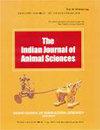Does selection index application for highly heritable traits need revisiting – A comprehensive study with bodyweight and shank length in Vanaraja male line chicken
IF 0.3
4区 农林科学
Q4 AGRICULTURE, DAIRY & ANIMAL SCIENCE
引用次数: 0
Abstract
Selection index (SI) is one of the best methods for estimating the breeding value of an animal combining all sources of information on the animal and its relatives. In the present study, the SI was constructed utilizing the five generations data of Vanaraja male line (PD-1) for body weight (BW-6) and shank length (SL-6) at 6 weeks of age with variance, covariance estimates and heritability of both the traits. The SI was employed on three generations data on simulation basis and the selection parameters were estimated and compared with the mass selection (MS) actually practiced in the population. The least squares mean of SL-6, the primary trait of selection increased from 76.63±0.002 (G-I) to 82.85 ±0.002 mm (G-II), and subsequently reduced to 80.17±001 mm (G-III). The BW-6 also followed similar trend. Generation had significant effect on both SL-6 and BW-6. The heritability estimates for SL-6 and BW-6 were moderate with 0.21 to 0.28 for SL-6 and 0.22 to 0.27 for BW-6. The two traits exhibited high degree of positive association with 0.87 to 0.92 correlation coefficient. The economic value estimated for weight and shank length was 1:8.95. Thus, the selection index constructed was I= 0.2260*BW6, g + 0.7717*SL6, mm. Selection differential was higher in SI method on pooled basis compared to MS in all three generations for the primary trait, SL-6. The response to selection and selection intensity was also higher in SI method compared to MS. A similar trend was observed for BW-6 with respect to selection differential and response to selection. The study concluded that SI was superior to mass selection based on the results in Vanaraja male line chicken.高遗传性状的选择指标应用是否需要重新审视——Vanaraja雄性系鸡体重和小腿长度的综合研究
选择指数(SI)是综合有关动物及其亲缘关系的所有信息来源估计动物育种价值的最佳方法之一。本研究利用Vanaraja雄性系(PD-1)的5代6周龄体重(BW-6)和腿长(SL-6)数据构建了SI,并对这两个性状进行方差、协方差估计和遗传力分析。在模拟的基础上对三代数据采用SI,估计选择参数,并与种群中实际进行的质量选择(MS)进行比较。主要选择性状SL-6的最小二乘平均值从76.63±0.002 (G-I)增加到82.85±0.002 mm (G-II),随后减少到80.17±001 mm (G-III)。BW-6也遵循了类似的趋势。代对SL-6和BW-6均有显著影响。SL-6和BW-6的遗传力估计中等,SL-6的遗传力估计为0.21 ~ 0.28,BW-6的遗传力估计为0.22 ~ 0.27。两性状呈高度正相关,相关系数为0.87 ~ 0.92。重量和柄长估算的经济价值为1:8.95。因此,构建的选择指数为I= 0.2260*BW6, g + 0.7717*SL6, mm。在混合基础上,SI法对主性状SL-6的选择差异均大于MS法。SI法对选择的响应和选择强度也高于ms法,BW-6在选择差异和选择响应方面也有类似的趋势。在Vanaraja雄性系鸡上的结果表明,SI优于质量选择。
本文章由计算机程序翻译,如有差异,请以英文原文为准。
求助全文
约1分钟内获得全文
求助全文
来源期刊

Indian Journal of Animal Sciences
农林科学-奶制品与动物科学
CiteScore
0.60
自引率
25.00%
发文量
220
审稿时长
8 months
期刊介绍:
Articles published in The Indian Journal of Animal Sciences encompass a broad range of research topics in animal health and production related to cattle, buffalo, sheep, goat, camel, equines, pig, rabbit, yak, mithun, poultry and fisheries. Studies involving wildlife species and laboratory animal species that address fundamental questions about their biology will also be considered for publication. All manuscripts must present some new development and must be original, timely, significant and scientifically excellent. Papers will be rejected if standards of care of, or procedures performed on animals are not up to those expected of humane veterinary scientists. At a minimum, standards must meet the International Guiding Principles for Biomedical Research involving Animals, as issued by the Council for International Organizations of Medical Sciences. (C.I.O.M.S., c/o WHO, CH 1211 Geneva 27, Switzerland). Articles reporting new animal disease must follow GOI directive as given in detail in Guidelines to Authors.
 求助内容:
求助内容: 应助结果提醒方式:
应助结果提醒方式:


